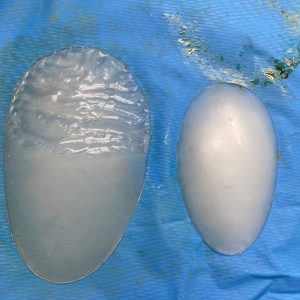Background: Aesthetic augmentation of the hips is far more challenging that other body areas for two reasons. First the common use of injection fat grafting, unlike that of the buttocks, has far less predictable results. Fat survives more poorly in the hips than the buttocks for unknown reasons. Second, there are no standard hip implants that are commercially available. There has been historically limited patient demand and this has resulted in a lack of extensive surgical experience in hip implant augmentation efforts.
Because of the dramatic surge in buttock augmentation request, primarily due to BBL surgery, it is a natural extension of those efforts to involve the adjoining hip areas. Without standard hip implants being available, surgeons will reach to use whatever implants may be available that seems suitable. In doing hip implant replacement surgeries I have seen many different types of implants placed into the hips including breast implants, buttock implants, and calf implants to name the most common.
Inevitably if the desired aesthetic hip augmentation effect is not achieved, secondary hip implant surgery will be sought. The one good thing about having any form of hip implant in place, its aesthetic effects allows the patient to know better about what additional effect is needed. If the exact indwelling implant shape and size are known this makes it easier to design a new custom hip implant that can be ore successful. Unfortunately, more times than not, the exact indwelling implants are not known. In this case the custom hip implant mat be designed based on external measurements with the surgeon being prepared to intraoperatively modify the implant as needed.





Secondary hip implants replacements can be successful. But even with custom hip implant designs there may always be the intraoperative need for implant modification along with pocket adjustment. (expansion capsulotomies)
Case Highlights:
1) There are no standard off the shelf hip implants so a wide variety of other body implant styles and sizes are encountered in hip implant replacements.
2) In hip implant replacements a custom hip implant is often needed to achieve a better hip contour.Hip implant replacements are usually done to achieve larger coverage of the hip area which requires an implant with an expanded surface area.
3) Because most indwelling hip implant shape and size is often unknown, any custom hip implant design has the potential to need intraoperative modification to fit into the expanded pocket as well as to achieve the desired aesthetic effect.
Dr. Barry Eppley
Indianapolis, Indiana



